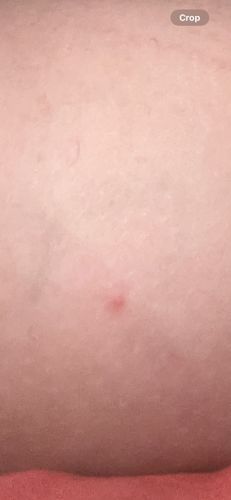Flea
Scientific Name: Ctenocephalides felis (cat flea - most common species found on both cats and dogs, and humans), Ctenocephalides canis (dog flea), Pulex irritans (human flea)
Order & Family: Order: Siphonaptera, Family: Pulicidae (common fleas)
Size: Adult fleas are typically 1.5 to 3.3 mm (0.06 to 0.13 inches) long, wingless, and reddish-brown to black in color.

Natural Habitat
Fleas thrive in warm, humid environments. They are commonly found in carpets, bedding, upholstered furniture, and cracks in floors, as well as on their hosts (pets like dogs and cats, and sometimes humans).
Diet & Feeding
Adult fleas are external parasites that feed on the blood of mammals and birds.
Behavior Patterns
Unlike typical flea activity, this image only shows a single, isolated bite mark without any visible insect. Flea bites usually appear as small, red, itchy bumps, often in clusters or lines, especially around ankles or warm body areas. Fleas are renowned for their impressive jumping abilities (up to 7 inches vertically), which allows them to easily move between hosts. They are ectoparasites, meaning they live on the outside of their hosts, and mature fleas can survive for several months without a blood meal. Larvae feed on organic debris, while adults feed exclusively on blood. This image shows a single red spot that looks like a singular bite.
Risks & Benefits
Risks: Flea bites can cause intense itching, leading to skin irritation and secondary infections from scratching. Some people can develop allergic reactions (flea allergy dermatitis). Fleas can also transmit diseases, though less common in humans, such as murine typhus and plague (historically significant, now rare). They are also intermediate hosts for tapeworms (e.g., Dipylidium caninum), which can infect pets and occasionally humans. Benefits: Fleas do not offer direct benefits to humans, and their ecological role is primarily as a food source for some predators.
Identified on: 9/4/2025